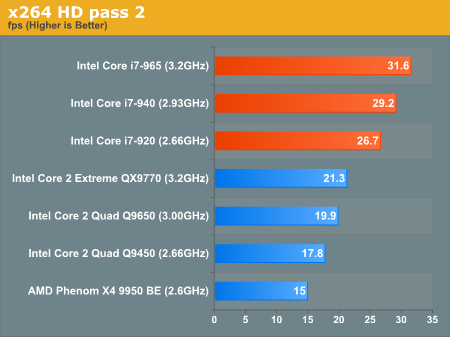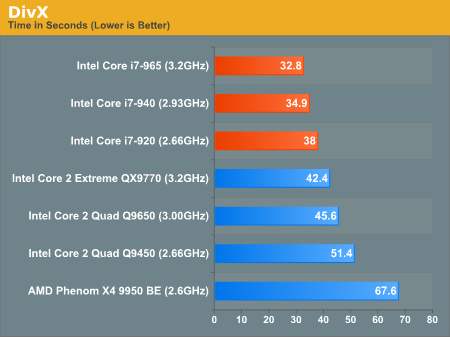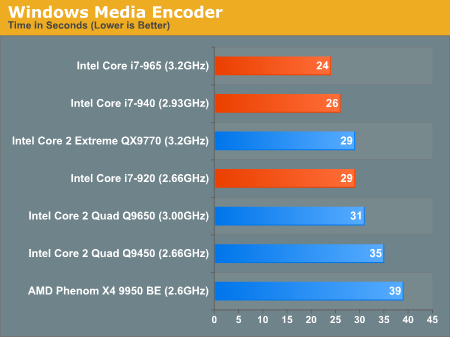The Dark Knight: Intel's Core i7
by Anand Lal Shimpi & Gary Key on November 3, 2008 12:00 AM EST- Posted in
- CPUs
Video and Media Encoding Performance
Nehalem is happiest in 3D rendering applications, but video encoding is a close second place. Our first video encoding test is Tech ARP's x264 HD benchmark, which does a test encode of a 720p source file using the x264 codec. We're reporting results from the 0.59.819 version of x264.

Here Nehalem can "only" deliver a 17% performance advantage over Penryn, but once again the $284 i7-920 is faster than the $1400 QX9770.

Our DivX test is the same DivX / XMpeg 5.03 test we've run for the past couple of years now, the 1080p source file is encoded using the unconstrained DivX profile, quality/performance is set balanced at 5 and enhanced multithreading is enabled:

You know the drill, Intel introduces a new architecture and obsoletes its old one - the i7-920 is looking mighty tempting...
The WME test gives us a little dose of reality, the i7-920 is only as fast as the QX9770 here:

Although this isn't a video encoding test I wanted to include a lighter workload to illustrate a situation where Nehalem is no faster than its predecessor. The iTunes benchmark is a simple WAV to MP3 encode and Nehalem isn't able to dominate here:

Penryn pulls slightly ahead at the top end but at 2.66GHz it falls slightly behind. In both cases the point is that you'll be faster with a QX9770 than an i7-920, and you'll be no faster with a Nehalem vs. Penryn.










73 Comments
View All Comments
Jingato - Monday, November 3, 2008 - link
If the 920 can easily be overclocked to 3.8Ghz on air, what intensive is there to purchase the 965 for more that triple the price?TantrumusMaximus - Monday, November 3, 2008 - link
I don't understand why the tests were on such low resolutions... most gamers are running higher res than 1280x1024 etc etc....What gives?
daniyarm - Monday, November 3, 2008 - link
Because if they ran gaming benchmarks at higher res, the difference in FPS would be hardly visible and you wouldn't go out and buy a new CPU.If they are going to show differences between Intel and AMD CPUs, show Nehalem at 3.2 GHz vs 9950 OC to 3.2 GHz so we can see clock for clock differences in performance and power.
npp - Monday, November 3, 2008 - link
9950 consumes about 30W more at idle than the 965XE, and 30W less under load. I guess that OC'ing it to 3,2Ghz will need more than 30W... Given that the 965 can process 4 more threads, I think the result should be more or less clear.tim851 - Monday, November 3, 2008 - link
Higher resolutions stress the GPU more and it will become a bottleneck. Since the article was focussing on CPU power and not GPU power they were lowering the resolution enough to effectively take the GPU out of the picture.Caveman - Monday, November 3, 2008 - link
It would be nice to see these CPU reviews use relevant "gaming" benchmarks. It would be good to see the results with something like MS flight simulator FSX or DCS Black Shark, etc... The flight simulators these days are BOTH graphically and calculation intensive, but really stress the CPU.AssBall - Monday, November 3, 2008 - link
No, they don't, actually.philosofool - Monday, November 3, 2008 - link
It would have been nice to see a proper comparison of power consumption. Given all of Intel's boast about being able to shut off cores to save power, I'd like to see some figures about exact savings.nowayout99 - Monday, November 3, 2008 - link
Ditto, I was wondering about power too.Anand Lal Shimpi - Monday, November 3, 2008 - link
Soon, soon my friend :)-A